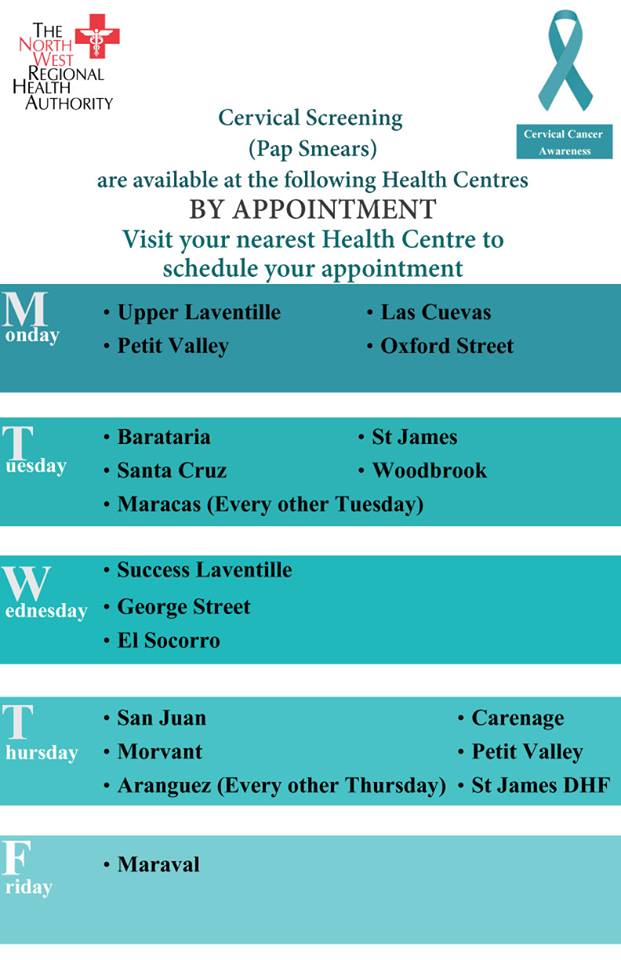Cervical Cancer, HPV and the need for Early Detection and Vaccination:
Cervical Cancer is the growth of abnormal, cancerous cells in the cervix, or the area at the opening of the uterus. It is the fourth most common cancer in women, and is also the fourth most common cause of death from cancer. Low and middle income countries, which include Trinidad and Tobago and most of the Caribbean, account for 90% of all worldwide deaths from this cancer. This high death rate is due largely to the late detection of the cancer, where it is advanced and more difficult to treat. High income countries have lowered their death rate from this cancer in two main ways: Pap Smear screening and Human Papilloma Virus (HPV) Vaccination.
The Pap Smear is a non-invasive test which can detect cervical cancer at much earlier stages, as the abnormal cells in the cervix can be detected before they are too mutated. Thus, there can be preventative measures and treatments put into place to prevent the furthering of the disease. Treatments can also be done at a much earlier time, when the cells are more susceptible. Countries which have introduced this test to all women have seen the rates of cancer drop by 80%, and deaths from the disease have dropped by 90%. Therefore, this simple 10 minute test, which is offered by the NWRHA, can reduce the burden of this disease on the women, her family and the community.
The HPV Virus causes 90% of all cervical cancer cases, as the virus causes mutations in the cells of the cervix, leading to the tumour growth, as well as genital warts. It is also linked to increased cancer incidence in the throat, mouth and other areas. This virus is easily transmitted from one person to the other, generally through sexual contact, but it can be transmitted by mother to child as well. It is the most common sexually transmitted infection, and it is estimated that 80% of all sexually active persons have contracted this disease.
The HPV Vaccine is a very safe method of preventing the contraction of the HPV virus, and thus reducing the incidence of cervical cancer, and the other cancers that this virus is linked to. The vaccine contains the non-infectious protein coat that covers the virus, which can stimulate the immune system, but cannot lead to disease. Thus, there are no chances of the vaccine causing HPV. It also contains very small amounts of non-toxic chemicals to stabilize the vaccine, including aluminum, L-arginine and other proteins, which have been found in large trials to have no negative effects. Over 100 million vaccines have been distributed to 100 countries worldwide, and negative effects have largely not been observed. In countries where this HPV vaccine has been introduced, the rates of cervical cancers have dropped by around 70%, as well as the frequency of other cancers linked to this virus, including head and neck. Death rates from these cancers have also dropped.
By combining both the HPV vaccine and the pap smear, as now recommended by the World Health Organization (WHO), developed countries have reduced the occurrence and impact of this cancer. As a population with a high risk for these cancers, Trinidad and Tobago is uniquely poised to also reduce the prevalence and impact of these cancers on the population by also following these guidelines. The NWRHA urges the population to support and participate in our pap smear and HPV Vaccination drives, as these will aid in maintaining a healthier population.
References:
- Shrestha AD, Neupane D, Vedsted P, Kallestrup P, (2018). “Cervical Cancer Prevalence, Incidence and Mortality in Low and Middle Income Countries: A Systematic Review.” Asian Pac J Cancer Prev. 19 (2): 319-324.
- WHO Report on Cervical Cancer, 2018.
- Canavan TP, Doshi NR, (2000). “Cervical cancer”. Am Fam Physician. 61 (5): 1369–76.









